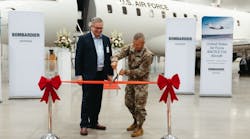PATUXENT RIVER NAS, Md. — U.S. Navy leaders are taking another step toward deploying pilotless helicopters equipped with infrared sensors for a wide variety of surveillance missions — particularly to help fine-tune naval gunfire.
Officials of the Naval Air Systems Command at Patuxent River Naval Air Station, Md., awarded a $14.2 million contract modification to the Northrop Grumman Corp. Ryan Aeronautical Center in San Diego to build one Fire Scout Vertical Take-Off and Landing Unmanned Aerial Vehicle (VTUAV) system.
The Fire Scout is to replace the Pioneer unmanned aerial vehicle (UAV) starting as early as this fall. Pioneer is a fixed-wing UAV with complex shipboard launch and recovery procedures. Its high mishap and limited performance were keys in the decision to replace it with the Fire Scout, Navy officials say.
Fire Scout is an unmanned helicopter designed to take off from and land on surface ships. It uses electro-optical/infrared sensors and a laser designator to find targets; track and designate targets; transmit targeting data to weapons, and assess battle damage. The new UAV also will act a communications node in tactical networks.
The VTUAV will particularly help ships equipped with extended-range guided munitions such as land-attack missiles and the 5-inch the Advanced Gun System.
Northrop Grumman's subcontractors include Schweizer Aircraft Corp. in Elmira, N.Y.; Lockheed Martin Federal Systems in Owego, N.Y.; L-3 Communications in Salt Lake City; and Sierra Nevada Corp. in Sparks, Nev.
Building the Fire Scout's sensor payload is Northrop Grumman's Electronic Sensors and Systems Sector in Baltimore, which is teamed with TAMAM-Israel Aircraft Industries in Yehud, Israel.
The Fire Scout can fly for as long as six hours, as fast as 125 knots, as far as 110 nautical miles, and can reach altitudes as high as 20,000 feet, Navy officials say.
For more, contact Northrop Grumman Corp. by phone at 310-553-6262, by fax at 310-553-2076, by post at 1840 Century Park East, Los Angeles, Calif. 90067-2199, or on the World Wide Web at http://www.northgrum.com/.


